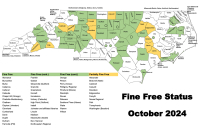Consolidated health department under discussion in Jackson
The Jackson County Commissioners got some food for thought during a meeting last week exploring the possibility of consolidating some of the county’s health and human resources services into a single department.
Public safety, transportation top Haywood budget wish list
Budgeting for the 2017-18 fiscal year is underway across the state, but in Haywood County, a decrease in property tax value makes this year’s process more bitter than sweet.
Candidate for Jackson commission alleges wrongdoing
 Mickey Luker has been working on a remodel of Caney Fork General Store ever since he purchased the property in 2011, but now the county commissioner candidate is claiming that politically motivated nefariousness caused the county health department to deny him the wastewater permit he needs to add a deli line to his business.
Mickey Luker has been working on a remodel of Caney Fork General Store ever since he purchased the property in 2011, but now the county commissioner candidate is claiming that politically motivated nefariousness caused the county health department to deny him the wastewater permit he needs to add a deli line to his business.
Swain sees Hepatitis B cases skyrocket
 The Swain County Health Department is concerned about the number of Hepatitis B cases confirmed in 2015.
The Swain County Health Department is concerned about the number of Hepatitis B cases confirmed in 2015.
Waynesville bans smoking on public sidewalks, subtly and with a smile
 A smoking ban in public places took effect in Waynesville last week, making it illegal to light up a cigarette on town sidewalks.
A smoking ban in public places took effect in Waynesville last week, making it illegal to light up a cigarette on town sidewalks.
Norovirus outbreak at North Canton Elementary winding down
 An outbreak of the highly contagious intestinal bug known as norovirus has been raging through North Canton Elementary School over the past two weeks, but illness now seems to be on the downswing — to the relief of parents and teachers alike.
An outbreak of the highly contagious intestinal bug known as norovirus has been raging through North Canton Elementary School over the past two weeks, but illness now seems to be on the downswing — to the relief of parents and teachers alike.
Sylva considers fencing in Scotts Creek
 To build a fence or to not build a fence?
To build a fence or to not build a fence?
It might not seem like such a portentous question, but as Sylva Town Commissioner Mary Gelbaugh found out when she asked her Facebook friends whether the town should look at putting a fence along Scotts Creek through Bridge Park, it kind of is. The comments came so thick and fast that Facebook contacted her to see if someone had hacked her account.
Jackson County ponders tobacco ban in public parks
Don’t light, chew, smoke or spit that tobacco in Jackson County parks, and if you do, you could be slapped with a $50 fine. That is the gist of a proposed law that will soon be voted on by county commissioners.
Jonathan Creek water interruptions leave some residents high and dry
 Joyce Porter had just finished cleaning her house in Jonathan Creek and was planning to hop in the shower, but when she turned on the faucet, no water came out.
Joyce Porter had just finished cleaning her house in Jonathan Creek and was planning to hop in the shower, but when she turned on the faucet, no water came out.
Prescription drug scourge claiming dozens of lives in Haywood
 The numbers are unforgiving.
The numbers are unforgiving.
One in three unexpected deaths in Haywood County are likely prescription drug overdoses. This year alone, there have been eight drug-related deaths — out of 25 unexpected deaths in all. And that doesn’t include two deaths last week that the county medical examiner suspects are overdoses as well.









